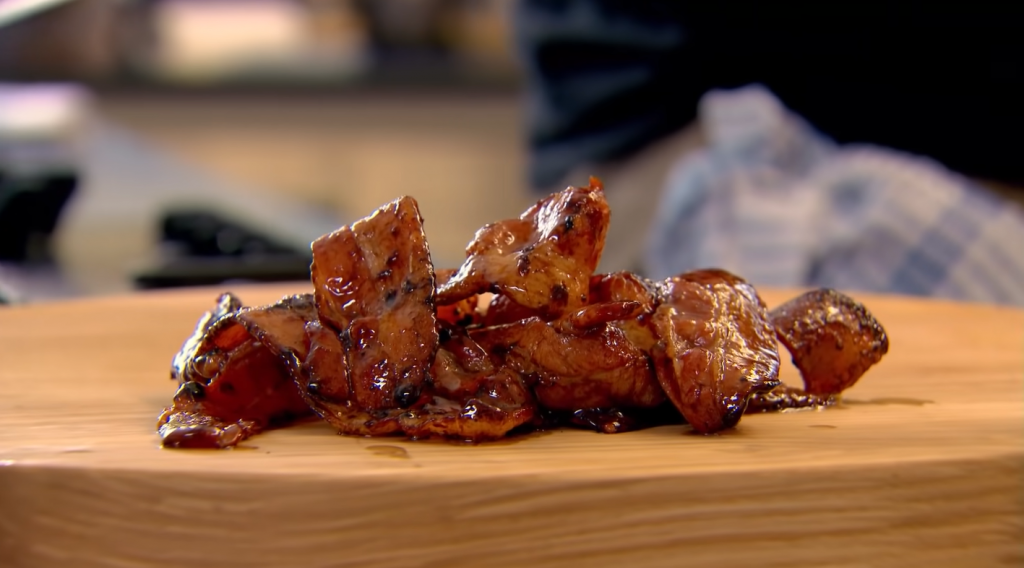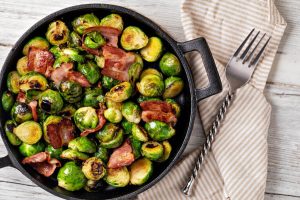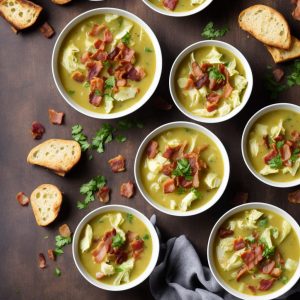Rendering bacon fat is a simple yet efficient way to add a rich, smoky flavor to your dishes. It is a classic technique used in many traditional recipes and can add depth to everything from roasted vegetables to baked goods. This recipe will guide you through the process of rendering bacon fat to achieve a clear, flavorful fat that can be stored and used in a variety of dishes.

The primary ingredient in this recipe, raw bacon, is a staple in many households and is readily available in most supermarkets. When choosing bacon for rendering, look for thicker cuts as they tend to have more fat. If thick-cut bacon is not available, using more strips of regular bacon will yield the same amount of fat.
Ingredients for Rendering Bacon Fat
raw bacon: Raw bacon is the only ingredient needed for this recipe. The fat from the bacon is rendered down into a grease that can be used in various recipes. Opt for high-quality, thick-cut bacon for the best results.
One reader, Cyrille Odonnell says:





This bacon fat recipe is a game-changer! The step-by-step instructions were easy to follow, and the end result was a jar of flavorful, golden fat that I can use for cooking. It's a great way to reduce waste and add a delicious touch to my dishes. Highly recommended!
Techniques for Rendering Bacon Fat
How to render bacon fat: A method for extracting and collecting the fat from bacon strips by cooking them until crispy and then straining the fat into a jar for future use.
How to store rendered bacon fat: After straining the fat into a jar, place it in the refrigerator, where it will solidify to a slightly off-color white, making it ready for use in future cooking.
How To Make Rendered Bacon Fat
Bacon fat is a versatile ingredient that adds a sumptuousness to every dish it touches. This recipe will teach you how to render and store it.
Serves:
Ingredients
- strips of raw bacon
Instructions
-
Heat a large skillet on medium-low heat. Lay out several strips of raw bacon. Let the strips cook for 10 or 15 minutes, turning them occasionally.
-
When the bacon strips are nicely browned and crispy, use tongs or a fork to lift them out of the pan and place them on paper towels (to absorb the excess fat) on a plate.
-
Pour the remaining fat in the pan into a jar, and put the jar into your refrigerator. The bacon grease will solidify to a slightly off-color white. When cooking bacon again, pull out the jar and add more of the excess fat to it.
-
The solid bacon bits can also be strained before pouring the fat into a jar.
Nutrition
- Calories: 120.93kcal
- Fat: 11.51g
- Saturated Fat: 3.86g
- Trans Fat: 0.04g
- Monounsaturated Fat: 5.06g
- Polyunsaturated Fat: 1.87g
- Carbohydrates: 0.37g
- Sugar: 0.29g
- Protein: 3.66g
- Cholesterol: 19.14mg
- Sodium: 191.98mg
- Calcium: 1.45mg
- Potassium: 57.42mg
- Iron: 0.12mg
- Vitamin A: 3.19µg
Pro Tip for Perfecting Rendered Bacon Fat
When rendering bacon fat, it's important to maintain a low and slow cooking process. This allows the fat to melt away from the meat without burning, resulting in a clear, flavorful fat that can be used in a variety of dishes. If the heat is too high, the bacon may burn before the fat is fully rendered, affecting the taste and quality of the fat.
Time-Saving Tips for Rendering Bacon Fat
Use pre-cooked bacon: Using pre-cooked bacon can save you time and effort, as it eliminates the need to render the fat yourself.
Batch cook: Cook a large amount of bacon at once and store the rendered fat for future use, saving time on the rendering process for each individual meal.
Chill quickly: After rendering the bacon fat, place it in the freezer for a quicker solidification process, allowing you to use it sooner.
Strain efficiently: Use a fine mesh strainer to efficiently separate the bacon bits from the rendered fat, saving time and ensuring a smoother texture.
Substitute Ingredients For Rendered Bacon Fat Recipe
- strips of raw bacon - Substitute with pancetta: Pancetta is an Italian bacon that has a similar flavor and texture, making it a great substitute for rendering fat.
- strips of raw bacon - Substitute with guanciale: Guanciale is an Italian cured meat made from pork jowl or cheeks, and it renders fat similarly to bacon, adding a rich flavor to dishes.
Presenting Your Rendered Bacon Fat
Elevate the dish with a bacon fat emulsion: Create a luxurious and flavorful bacon fat emulsion to drizzle over the dish, adding richness and depth of flavor.
Garnish with crispy bacon bits: Sprinkle crispy bacon bits over the dish for a delightful crunch and an extra burst of smoky bacon flavor.
Present in a sophisticated jar: Serve the rendered bacon fat in an elegant jar, showcasing its golden hue and enticing aroma.
Accompany with artisan bread: Provide freshly baked artisan bread to accompany the rendered bacon fat, allowing guests to savor every last bit of its savory goodness.
Pair with a complementary dish: Pair the rendered bacon fat with a complementary dish, such as roasted vegetables or seared scallops, to enhance the overall dining experience.
Essential Tools for Rendering Bacon Fat
- Cutting board: A flat surface used for cutting, slicing, and preparing ingredients.
- Chef's knife: A versatile kitchen knife used for a variety of tasks such as chopping, slicing, and dicing.
- Skillet: A frying pan with a flat bottom and low sides, used for frying, searing, and sautéing.
- Tongs: A utensil with two arms and a pivot used for gripping and lifting items, such as turning bacon strips while rendering fat.
- Paper towels: Absorbent paper used to drain and absorb excess fat or moisture from cooked foods.
Storing and Freezing Rendered Bacon Fat
Store the rendered bacon fat in a clean, airtight container or jar with a tight-fitting lid. This will help prevent the fat from absorbing any unwanted odors or flavors from other foods in your refrigerator.
Before storing the bacon fat, make sure it has cooled down to room temperature. Pouring hot fat into a container can cause it to crack or melt, especially if using a plastic container.
If you plan to use the bacon fat within a few weeks, you can store it in the refrigerator. It will solidify and keep for up to a month.
For longer storage, you can freeze the bacon fat. Pour the cooled, strained fat into an ice cube tray or a silicone mold. Once frozen, pop out the bacon fat cubes and store them in a freezer-safe bag or container. Label the container with the date and amount of fat.
Frozen bacon fat can be stored for up to 6 months. When you need to use it, simply take out the desired amount and let it thaw in the refrigerator or at room temperature.
To prevent the bacon fat from going rancid, make sure to store it in a cool, dark place away from direct sunlight or heat sources.
If you notice any off smells, mold, or discoloration in your stored bacon fat, discard it immediately to avoid any potential food safety issues.
How To Reheat Rendered Bacon Fat
The best way to reheat leftover bacon fat is to scoop out the desired amount and place it in a small saucepan or skillet over low heat. Gently warm the fat, stirring occasionally, until it melts and becomes liquid again. This method ensures that the bacon fat retains its flavor and consistency without burning or becoming rancid.
Another option is to place the desired amount of solidified bacon fat in a microwave-safe dish and heat it in short intervals (about 10-15 seconds at a time) on medium power, stirring between each interval until the fat is melted and warm. Be careful not to overheat the fat, as it can splatter and cause burns.
If you plan to use the reheated bacon fat for sautéing or frying, you can simply add it directly to the pan or skillet as it heats up. The fat will melt and become liquid as the pan warms, allowing you to cook your ingredients in the flavorful bacon fat.
When reheating bacon fat, always use low to medium heat and stir frequently to prevent scorching or burning. Overheating the fat can cause it to smoke, develop off-flavors, and potentially become rancid more quickly.
Store any unused reheated bacon fat in an airtight container in the refrigerator for future use. Properly stored, the fat should remain fresh for several weeks to a few months.
Interesting Fact About Rendering Bacon Fat
Bacon fat can be used as a flavorful substitute for butter or oil in various recipes, adding a rich and smoky flavor to dishes. It can be used to enhance the taste of vegetables, eggs, and even baked goods. Additionally, bacon fat can be stored in the refrigerator for several weeks, making it a convenient and versatile ingredient to have on hand.
Is Rendering Bacon Fat Cost-Effective?
This bacon fat recipe is highly cost-effective for a household. The use of leftover bacon fat reduces the need for additional cooking oils, saving money in the long run. With a rich flavor, the rendered fat can enhance various dishes, making it a versatile and valuable addition to the kitchen. The approximate cost for a household of 4 people is minimal, as it utilizes a byproduct that would otherwise be discarded. Overall Verdict: 9/10
Is Rendering Bacon Fat Healthy or Unhealthy?
Rendering bacon fat is a process that results in a tasty cooking fat, but it is not considered a healthy recipe from a nutritional standpoint. Here's why:
- Bacon is high in saturated fat, which can raise LDL (bad) cholesterol levels and increase the risk of heart disease and stroke when consumed in excess.
- Bacon is also high in sodium, which can lead to high blood pressure and other health issues when consumed in large amounts.
- The process of rendering bacon fat does not remove any of these unhealthy components, and the resulting fat is still high in saturated fat and sodium.
While bacon fat can add flavor to dishes, it should be used sparingly in a balanced diet.
To make this recipe healthier, consider the following suggestions:
- Use bacon fat in moderation, and opt for healthier cooking oils like olive oil or avocado oil for everyday cooking.
- When using bacon fat, combine it with other, healthier fats to balance out the nutritional profile of the dish.
- Choose bacon that is lower in sodium and fat, such as uncured or turkey bacon, to reduce the overall intake of these less healthy components.
- Incorporate more vegetables and lean proteins into your meals to create a more balanced and nutritious diet overall.
Editor's Opinion on Rendering Bacon Fat
This recipe provides a simple and effective method for rendering bacon fat, which can be a versatile and flavorful addition to various dishes. The instructions are clear and easy to follow, making it accessible for home cooks. However, it's important to note that the cooking time and heat level may vary depending on the thickness of the bacon slices and individual stovetop settings. Overall, this recipe offers a practical way to save and utilize bacon fat for enhancing the taste of future culinary creations.
Enhance Your Rendered Bacon Fat Recipe with These Unique Side Dishes:
Recipes Similar to Rendering Bacon Fat
Why trust this Rendered Bacon Fat Recipe:
This recipe for rendering bacon fat is a tried and true method that has been passed down through generations of chefs. The process of slowly cooking the bacon strips allows for the fat to be released and collected, resulting in a rich and flavorful bacon fat that can be used for enhancing the taste of various dishes. The simplicity of the instructions ensures that the bacon fat is rendered to perfection, providing a reliable and delicious ingredient for cooking. Trust in the time-honored tradition of rendering bacon fat and elevate your culinary creations with its savory essence.
Was this page helpful?
Have your own special recipe to share? Submit Your Recipe Today!














